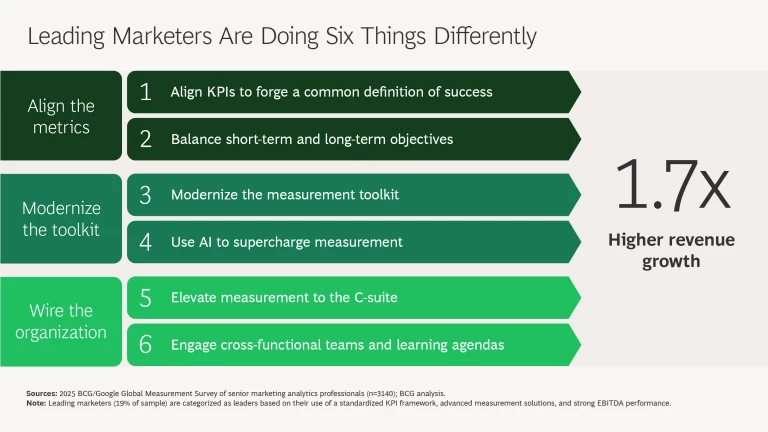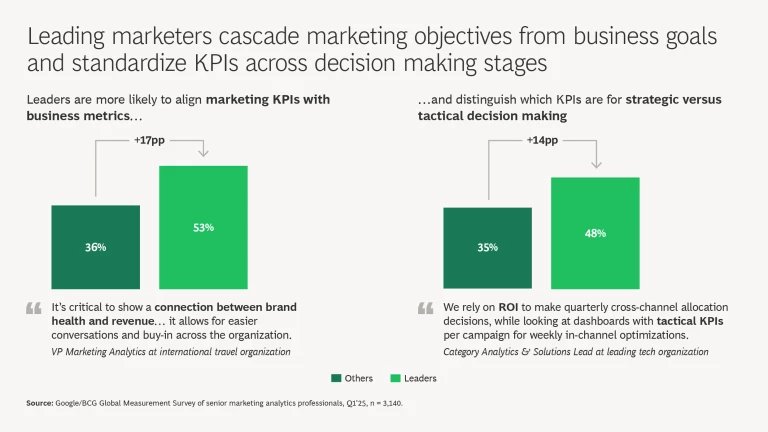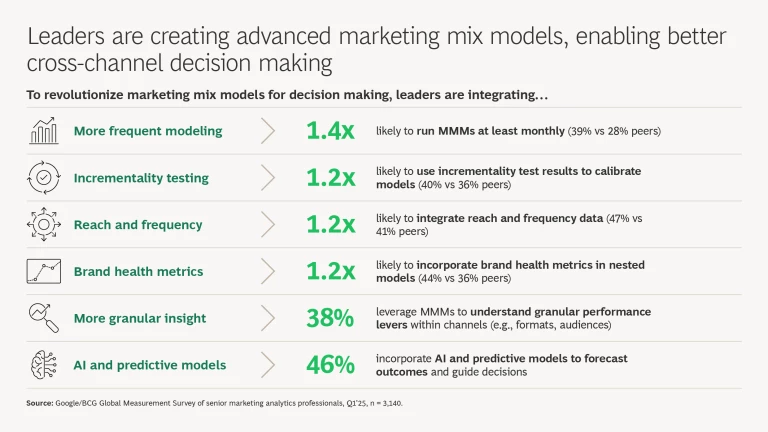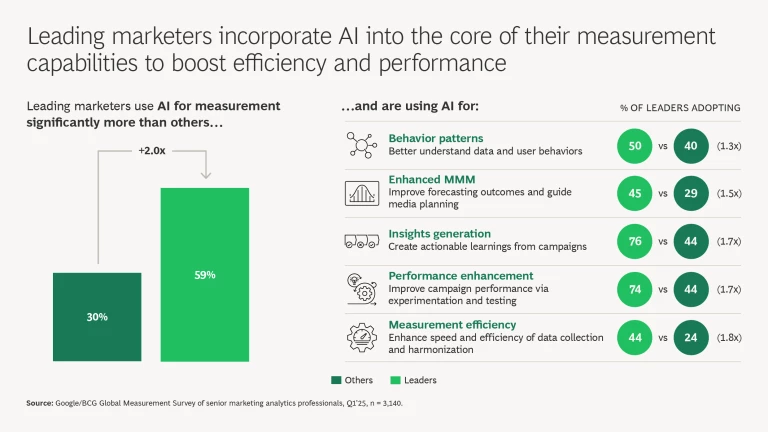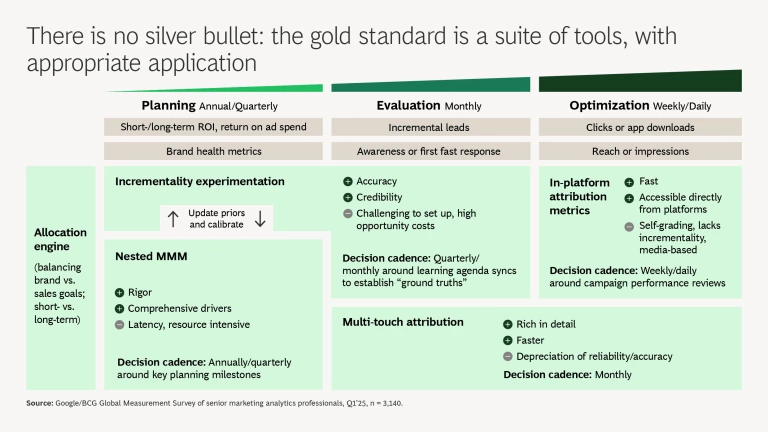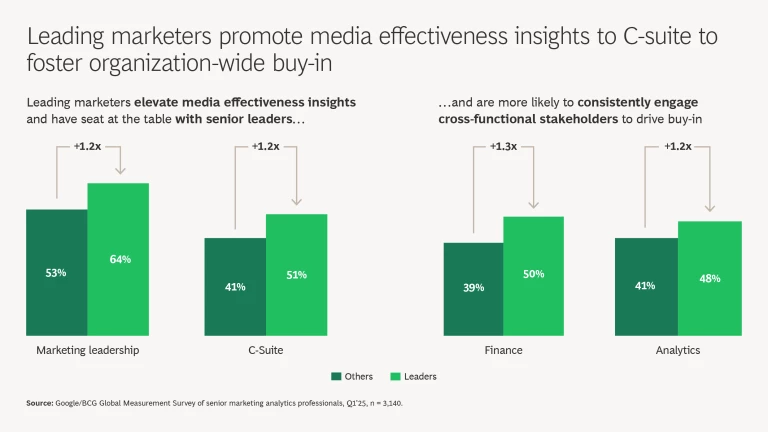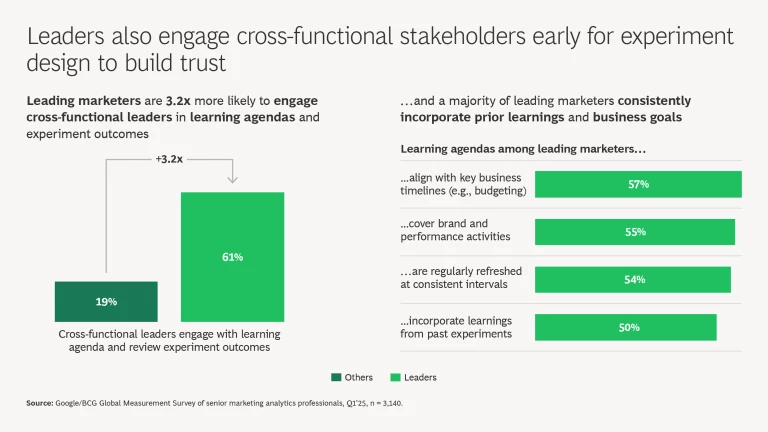Everywhere you look, AI appears to be making magic, rapidly amplifying outcomes across business functions. In marketing, it has enabled companies to develop creative assets in a day and conduct dozens of multivariate tests simultaneously, synthesizing results to obtain insights in a fraction of the time it would normally take. So it’s little wonder that AI has also raised C-suite expectations concerning how accurately the effectiveness of marketing investments can be measured. Meeting these expectations has not been easy. More than 70% of marketers today are using AI in their measurement toolkit, but this has not yet led to clear improvements in all cases—nearly one in three of all marketers consider evaluating media effectiveness across channels as their biggest challenge.
This finding underscores the fact that AI and other technologies are only part of the answer. Without an underpinning of sound marketing measurement processes, AI cannot deliver fully on the potential benefits. In other words, unless you get the basics right, the rewards of using AI to measure marketing efforts will remain out of reach. To find out who is doing it right—and how—we surveyed 3,000 senior measurement professionals worldwide.
The challenges with marketing measurement are familiar and numerous: too many KPIs, fragmented toolkits, discrepancy between short- and long-term goals, data that’s hard to access, and organizational siloes. However, a subset of leading
As part of this effort, we developed a Measurement Effectiveness Framework: a structured model that helps marketers integrate measurement across the entire business cycle, from strategic planning and tactical evaluation to operational optimization. (See the exhibit.)
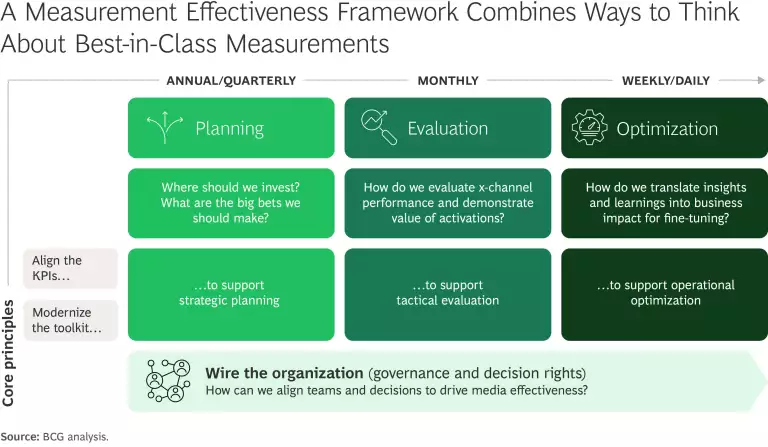
How Leading Marketers Optimize Measurement—and Increase Growth
Our research revealed six pivotal actions that leading organizations are taking to master marketing measurement and boost their impact and competitive advantage.
The slideshow provides further detail from our survey and the Measurement Effectiveness Framework.
1. Align KPIs to forge a common definition of success.
Different functions in an organization often track many different metrics—for example, digital conversions by media channel (often based on the “last touch” traffic source) and incremental sales or ROI (often based on a marketing mix model, MMM). These metrics can each serve a purpose, but often can lead to contradictory conclusions and leave measurement professionals with no way to stitch the metrics together. To overcome this, leaders pinpoint the one or two “north star” KPIs that truly matter when it comes to making decisions about trade-offs and strategy. And half of these leaders go further, by aligning their marketing KPIs with business outcomes. These KPIs become a shared “currency” across teams, with all other metrics laddering up to them.
Take, for example, the global financial services firm whose marketers were struggling to measure their multichannel impact. Partnering with finance and analytics, they introduced a single master metric: marginal ROI (mROI). This gave finance and marketing one language, enabling them to compare channel performance quickly and prune underperforming campaigns. As a result, the firm improved marketing efficiency by about 10% and significantly boosted the credibility of marketing leaders.
In another case, an omnichannel telco’s digital site team tracked last-touch metrics, such as site visits and sources of traffic that drove digital conversion, whereas the media team looked at the holistic omnichannel impact of media spending. These two views surfaced insights that suggested completely opposing actions. What the organization needed was a way to connect these two views with a common language. The teams found that when they aligned on a holistic approach to what metrics and tools would be used for planning versus evaluation versus optimization, they could more easily understand the correlation between the KPIs and tie them to holistic business outcomes (new accounts added). This enabled them to make spend allocation decisions effectively with CFO buy-in.
Stay ahead with BCG insights on marketing and sales
2. Balance short- and long-term objectives.
Three-quarters of leaders from our survey factor in long-term outcomes in their evaluation of marketing effectiveness, and half ensure their KPI framework includes both brand and performance KPIs. Notably, leaders distinguish between tactical and strategic KPIs to differentiate between short-term outcomes (like sales) and long-term outcomes (like brand-building). In this way, they align marketing objectives with business objectives. One way leading marketers are capturing long-term outcomes is by integrating brand metrics (such as awareness and consideration) into their MMM to reflect future revenue potential.
A global e-commerce company was struggling to compare performance marketing and brand spend to strike the right balance for long-term value creation. The marketing team realized the challenge wasn’t about choosing between the two, but rather about developing a unified way to measure—and optimize—both. To balance short- and long-term objectives, they began correlating both types of spend to gross merchandise value (GMV).
The marketing team built a universal measurement framework that allowed direct comparison across brand and performance marketing efforts. Using causal inference, they established the incremental impact of both short-term (performance) and long-term (brand) metrics on GMV over a two-year period. This ensured that allocation decisions were made with a long-term view in mind.
By linking brand scores to future bookings, the company was able to justify ongoing brand investments without compromising short-term ROI. Based on these insights, the leadership team made the decision to more than double brand channel spend.
3. Modernize the measurement toolkit.
Nearly half (46%) of marketers we surveyed use the trifecta of measurement solutions: MMM for strategic planning, incrementality testing to glean causal insights, and multi-touch attribution (MTA) for daily optimization. But only the leading marketers integrate these approaches, so that each informs the other and amplifies value. The leaders also run MMMs more frequently than their peers (39% do so monthly), use incrementality results to establish ground truths and calibrate MMMs (40%), and incorporate brand health metrics in nested models. AI-powered predictive modeling then turns the MMM into a proactive, real-time optimization tool.
Consider an over-the-top media player that spends $500 million across more than 10 channels to acquire streaming customers. As the company’s growth ambitions rose, it became increasingly necessary to optimize spend across geographies, channels, and formats in real time. The company built two granular MMMs: one for brand-channel mix and one for performance-channel mix. Each month it refined the models using geo-based experiments as key calibration points. Given the increasing online privacy restrictions and declining accuracy of MTA, the company decided to prioritize incrementality tests as a source of ground truth, which not only enhanced model accuracy but also boosted organization-wide adoption with finance stakeholders. Finally, the company enabled continuous optimization by integrating first-party data, attribution insights, user test results, and external factors like seasonality and travel trends. Through frequent updates and calibration, the platform was able to optimize brand spend across its channels, raising marketing spend efficiency by 20%.
4. Use AI to supercharge measurement.
Leading marketers are twice as likely as their peers to embed AI into the core of their measurement approach—unlocking faster, smarter decisions and stronger performance. They’re using AI to update MMM more frequently, integrating brand tracking metrics, first-party data, and predictive models to enable real-time scenario planning and investment shifts.
But AI’s role goes well beyond tracking results. Half of leaders use it to spot behavioral patterns—analyzing browsing, purchase, and engagement signals to better personalize content and offers. Meanwhile, 45% enhance media planning through AI-powered MMM, enabling more precise forecasts and near-real-time optimization of channel spend.
The biggest gains come in speed and insight. Just over three-quarters (76%) of leaders use AI to:
- Surface real-time insights from auto-analyzing campaign, creative, and customer data
- Run experiments on creative, bidding, and targeting to improve campaign performance
- Automate data ingestion and harmonization to create unified, up-to-date dashboards that reduce time to insight
These capabilities collectively reduce manual work, accelerate decision making, and transform marketing measurement into a predictive, high-performance engine.
One e-commerce affiliate site offers a clear example. It previously spent six months on media planning, largely guided by opinion and gut feel. After adopting predictive AI models fueled by audience data, it could forecast performance across channel mixes and test scenarios faster. Quarterly budget optimization and rapid test-and-learn cycles to inform offers became the norm, cutting planning time by 66% and lifting brand awareness by 11% through more agile, data-driven decisions.
The two final actions relate to perhaps the most important part of the leading marketer’s agenda: “wiring the organization.” Notably, this step cannot happen if measurement remains stuck within marketing.
5. Elevate measurement to the C-suite.
More than half of best-in-class measurement professionals share media effectiveness insights directly with leadership, ensuring they are a core input to budgeting and investment decisions. Embedding monthly MMM reviews into CFO meetings can transform measurement from a marketing “side show” into a strategic revenue lever. This kind of transparency builds trust, promotes alignment among stakeholders, and enables companies to move faster and more confidently when shifting spending or testing new channels.
Consider the global financial institution that could not determine the ROI of its marketing efforts across channels—and was unable to reconcile different results across solutions. Marketing struggled to sell executives on MMM because of a history of mistrust. To move forward, the company assembled a data science team with marketing analytics expertise to boost MMM accuracy. It then fostered organization-wide buy-in by holding frequent insight sessions. By aligning its multi-touch attribution to its MMM outputs, marketing established a clearer picture of individual channel performance and was able to anchor strategic-level insights to a single tool. It shifted the culture away from last-touch attribution by elevating MMM insights to the C-suite in monthly business reviews. Finally, it created a monthly dashboard with streamlined data to give executives visibility into the latest model insights. These actions not only heightened transparency and trust, they also helped decision makers move from insight to action faster.
6. Engage cross-functional teams and learning agendas.
The second element of wiring the organization involves collaborating with finance, analytics, product, and other teams. Over 60% of leading marketers work with their cross-functional peers to design experiments and align with them on testing timelines and success factors.
A European food delivery platform illustrates the power of cross-functional collaboration and transparency. Marketing had struggled to gain buy-in from finance on its MMM insights. The finance team was invited to help generate hypotheses and test roadmaps, gaining a clearer understanding of media spend and results. Marketing held regular check-ins with finance to jointly fine-tune budgets. The two teams refined MMM models based on actual campaign learnings. Through this partnership, they improved EBITDA and marketing gained greater flexibility to shift spend effectively.
Getting Started on the Path to Become a Marketing Measurement Leader
While 30% of the measurement battle is assembling the right KPIs and toolkit, 70% is getting the people and processes in place to enable those KPIs and tools to work their magic.
As the above examples show, sparking transformation in measurement is within reach of every marketing organization. The following steps will help you get started.
- Identify a common KPI currency. Work with finance and other key functions to establish a framework that balances short-term KPIs (such as incremental leads and ROI) and long-term measures (such as brand equity). This creates a common language and definition of success.
- Deploy incrementality experiments. Validate assumptions from your MMM or MTA process in real-world conditions.
- Update your MMM frequently. Put AI to work to conduct monthly or quarterly refreshes to cut time to insight.
- Scale up AI. Enhance measurement with AI-driven automation to generate insights and predict campaign outcomes.
- Establish cross-functional learning agendas. Bring finance and product teams into the fold and embed measurement in their reviews to create shared accountability. Peer teams become more invested in marketing and more willing to provide it with the resources and flexibility necessary to enable success.
- Elevate the role of measurement. Schedule quarterly reviews with C-suite, cross-functional leaders to leverage insights for business decision making.
The speed and power of new AI capabilities facilitate measurement as never before. But integration is as much a people process as anything else. By taking these six pivotal actions, marketers can demonstrate ROI, fuel more effective decision making, augment revenue growth, and amplify their competitive positioning.


